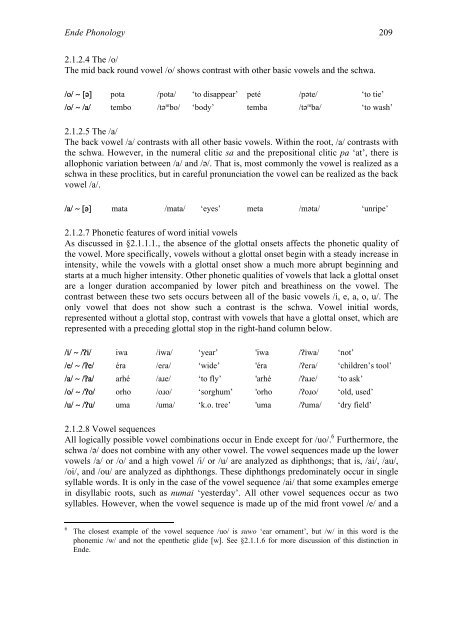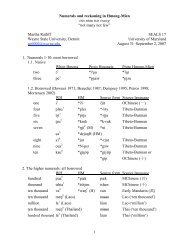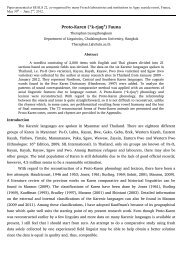proto-southwestern-tai revised: a new reconstruction - seals 22
proto-southwestern-tai revised: a new reconstruction - seals 22
proto-southwestern-tai revised: a new reconstruction - seals 22
You also want an ePaper? Increase the reach of your titles
YUMPU automatically turns print PDFs into web optimized ePapers that Google loves.
Ende Phonology 209<br />
2.1.2.4 The /o/<br />
The mid back round vowel /o/ shows contrast with other basic vowels and the schwa.<br />
/o/ ~ [�] pota /pota/ ‘to disappear’ peté /p�te/ ‘to tie’<br />
/o/ ~ /a/ tembo /t�mbo/ ‘body’ temba /t�mba/ ‘to wash’<br />
2.1.2.5 The /a/<br />
The back vowel /a/ contrasts with all other basic vowels. Within the root, /a/ contrasts with<br />
the schwa. However, in the numeral clitic sa and the prepositional clitic pa ‘at’, there is<br />
allophonic variation between /a/ and /�/. That is, most commonly the vowel is realized as a<br />
schwa in these proclitics, but in careful pronunciation the vowel can be realized as the back<br />
vowel /a/.<br />
/a/ ~ [�] mata /mata/ ‘eyes’ meta /m�ta/ ‘unripe’<br />
2.1.2.7 Phonetic features of word initial vowels<br />
As discussed in §2.1.1.1., the absence of the glottal onsets affects the phonetic quality of<br />
the vowel. More specifically, vowels without a glottal onset begin with a steady increase in<br />
intensity, while the vowels with a glottal onset show a much more abrupt beginning and<br />
starts at a much higher intensity. Other phonetic qualities of vowels that lack a glottal onset<br />
are a longer duration accompanied by lower pitch and breathiness on the vowel. The<br />
contrast between these two sets occurs between all of the basic vowels /i, e, a, o, u/. The<br />
only vowel that does not show such a contrast is the schwa. Vowel initial words,<br />
represented without a glottal stop, contrast with vowels that have a glottal onset, which are<br />
represented with a preceding glottal stop in the right-hand column below.<br />
/i/ ~ /Ɂi/ iwa /iwa/ ‘year’ 'iwa /Ɂiwa/ ‘not’<br />
/e/ ~ /Ɂe/ éra /eɾa/ ‘wide’ 'éra /Ɂeɾa/ ‘children’s tool’<br />
/a/ ~ /Ɂa/ arhé /aɹe/ ‘to fly’ 'arhé /Ɂaɹe/ ‘to ask’<br />
/o/ ~ /Ɂo/ orho /oɹo/ ‘sorghum’ 'orho /Ɂoɹo/ ‘old, used’<br />
/u/ ~ /Ɂu/ uma /uma/ ‘k.o. tree’ 'uma /Ɂuma/ ‘dry field’<br />
2.1.2.8 Vowel sequences<br />
All logically possible vowel combinations occur in Ende except for /uo/. 6 Furthermore, the<br />
schwa /�/ does not combine with any other vowel. The vowel sequences made up the lower<br />
vowels /a/ or /o/ and a high vowel /i/ or /u/ are analyzed as diphthongs; that is, /ai/, /au/,<br />
/oi/, and /ou/ are analyzed as diphthongs. These diphthongs predominately occur in single<br />
syllable words. It is only in the case of the vowel sequence /ai/ that some examples emerge<br />
in disyllabic roots, such as numai ‘yesterday’. All other vowel sequences occur as two<br />
syllables. However, when the vowel sequence is made up of the mid front vowel /e/ and a<br />
6 The closest example of the vowel sequence /uo/ is suwo ‘ear ornament’, but /w/ in this word is the<br />
phonemic /w/ and not the epenthetic glide [w]. See §2.1.1.6 for more discussion of this distinction in<br />
Ende.





